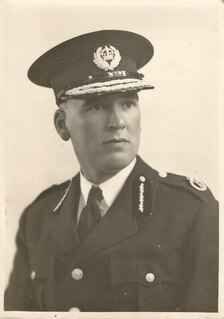Footnotes
- ↑ History of Cleveland Police
- ↑ Middlesbrough Borough Treasurer's Department, Return of Officials and Workmen in the Employment of the Corporation at March 1934
Middlesbrough Borough Police, sometimes referred to as Middlesbrough Constabulary, was the police force of Middlesbrough, England, established in 1853. [1] On 1 April 1968, the force was amalgamated into Teesside Constabulary, which itself became part of Cleveland Constabulary in 1974.
In 1934, the force had a strength of one Chief Constable, one Chief Inspector, six Inspectors, twenty Sergeants, 136 Constables, three Matrons, and eight civilian staff. [2]
Most of the police forces of the United Kingdom use a standardised set of ranks, with a slight variation in the most senior ranks for the Metropolitan Police and City of London Police. Most of the British police ranks that exist today were chosen by Home Secretary Sir Robert Peel, the founder of the Metropolitan Police, enacted under the Metropolitan Police Act 1829. The ranks at that time were deliberately chosen so that they did not correspond with military ranking, because of fears of a paramilitary force.

Cleveland Police is the territorial police force responsible for the policing area corresponding to the former county of Cleveland in Northern England. As of September 2017, the force had 1,274 police officers, 278 police staff, 124 police community support officers and 64 special constables. In the 2019 annual assessment by Her Majesty's Inspectorate of Constabulary, Cleveland Police was rated 'inadequate' overall and rated 'inadequate' in all review areas.

Durham Constabulary is the territorial police force responsible for policing ceremonial county of County Durham in North East England. The force’s area is bordered by Cumbria Constabulary to the west, Cleveland Police to the south east, North Yorkshire Police to the south and Northumbria Police to the north.

Sussex Police is the territorial police force responsible for policing in the whole of Sussex. Its jurisdiction covers the ceremonial counties of East Sussex and West Sussex. The force is headquartered in Malling House, Lewes, East Sussex.

Nottinghamshire Police is the territorial police force responsible for policing the shire county of Nottinghamshire and the unitary authority of Nottingham in the East Midlands of England. The area has a population of just over 1 million.

Lincolnshire Police is the territorial police force covering the non-metropolitan county of Lincolnshire in the East Midlands of England. Despite the name, the force's area does not include North East Lincolnshire and North Lincolnshire, which are covered by Humberside Police instead.

The Isle of Man Constabulary is the national police service of the Isle of Man, an island of 85,000 inhabitants, situated approximately equidistant from Northern Ireland, Wales, Scotland and England.

The West Yorkshire Constabulary (WYC) was, from 1968 to 1974, the statutory police force for the West Riding of Yorkshire, in northern England.
Reading Borough Police was a police force for the borough of Reading in the United Kingdom. The force was created on 21 February 1836, at which time it had a strength of 30 constables, two sergeants and two inspectors. Towards the end of the 19th century, Reading Borough Police had increased in size to 62 officers. However, the local population had risen to around 60,500, which meant one officer for every 1,000 inhabitants. By the time of the First World War the force had an establishment of 113 officers, however, due to military service only 30 officers were patrolling Reading.
Sir John Lovegrove Waldron KCVO was a British police officer who served as Chief Constable of Berkshire Constabulary from 1954 to 1958 and Commissioner of the London Metropolitan Police from 1968 to 1972.
Northumberland Constabulary was the Home Office police force for the county of Northumberland, England, from 1969 until 1974.

The River Tyne Police was a police force established under the Newcastle upon Tyne Port Act 1845 which patrolled the River Tyne in England between 1845 and 1968.
The North Riding of Yorkshire Constabulary was the territorial police force for the North Riding of Yorkshire from 1856 to 1968.
Head constable was a rank used in some British and British colonial police forces, and is still used in the Indian police.

Teesside was, from 1968 to 1974, a local government district in northern England. It comprised a conurbation that spanned both sides of the River Tees from which it took its name. Teesside had the status of a county borough and was independent of the county councils of the North Riding of Yorkshire, and County Durham. The Lord Lieutenant of the North Riding of Yorkshire represented the whole of Teesside, including those areas north of the Tees which were in Durham.
The New Year Honours 1913 were appointments by King George V to various orders and honours to reward and highlight good works by members of the British Empire. They were announced on 3 January 1913.
The New Year Honours 1914 were appointments by King George V to various orders and honours to reward and highlight good works by members of the British Empire. They were announced on 2 January 1914.
Penzance Borough Police was the police force for the borough and corporate town of Penzance, Cornwall, from 1836 to 1947. It was formed following the passing of the Municipal Corporations Act 1835, which reformed all UK boroughs, and stipulated that each appoint a Watch Committee to oversee a police force. The police force formed part of the commonality of the town's government, led by an elected Mayor, six aldermen and eighteen councillors.

Frederick George Beale was a British police officer and Chief Constable.
The East Riding of Yorkshire Constabulary was the territorial police force for policing the East Riding of Yorkshire from 1856 to 1968.